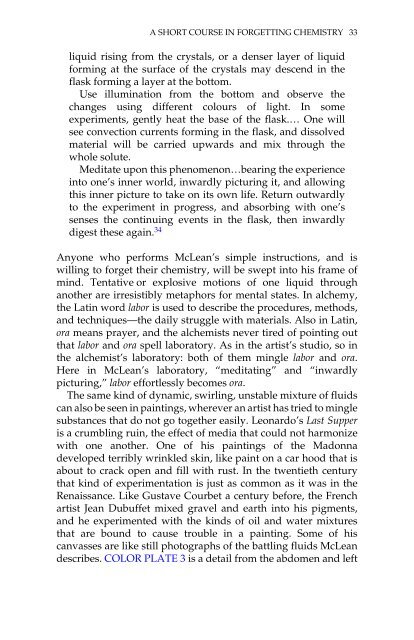What Painting Is: How to Think about Oil Painting ... - Victoria Vesna
What Painting Is: How to Think about Oil Painting ... - Victoria Vesna
What Painting Is: How to Think about Oil Painting ... - Victoria Vesna
Create successful ePaper yourself
Turn your PDF publications into a flip-book with our unique Google optimized e-Paper software.
A SHORT COURSE IN FORGETTING CHEMISTRY 33<br />
liquid rising from the crystals, or a denser layer of liquid<br />
forming at the surface of the crystals may descend in the<br />
flask forming a layer at the bot<strong>to</strong>m.<br />
Use illumination from the bot<strong>to</strong>m and observe the<br />
changes using different colours of light. In some<br />
experiments, gently heat the base of the flask.… One will<br />
see convection currents forming in the flask, and dissolved<br />
material will be carried upwards and mix through the<br />
whole solute.<br />
Meditate upon this phenomenon…bearing the experience<br />
in<strong>to</strong> one’s inner world, inwardly picturing it, and allowing<br />
this inner picture <strong>to</strong> take on its own life. Return outwardly<br />
<strong>to</strong> the experiment in progress, and absorbing with one’s<br />
senses the continuing events in the flask, then inwardly<br />
digest these again. 34<br />
Anyone who performs McLean’s simple instructions, and is<br />
willing <strong>to</strong> forget their chemistry, will be swept in<strong>to</strong> his frame of<br />
mind. Tentative or explosive motions of one liquid through<br />
another are irresistibly metaphors for mental states. In alchemy,<br />
the Latin word labor is used <strong>to</strong> describe the procedures, methods,<br />
and techniques—the daily struggle with materials. Also in Latin,<br />
ora means prayer, and the alchemists never tired of pointing out<br />
that labor and ora spell labora<strong>to</strong>ry. As in the artist’s studio, so in<br />
the alchemist’s labora<strong>to</strong>ry: both of them mingle labor and ora.<br />
Here in McLean’s labora<strong>to</strong>ry, “meditating” and “inwardly<br />
picturing,” labor effortlessly becomes ora.<br />
The same kind of dynamic, swirling, unstable mixture of fluids<br />
can also be seen in paintings, wherever an artist has tried <strong>to</strong> mingle<br />
substances that do not go <strong>to</strong>gether easily. Leonardo’s Last Supper<br />
is a crumbling ruin, the effect of media that could not harmonize<br />
with one another. One of his paintings of the Madonna<br />
developed terribly wrinkled skin, like paint on a car hood that is<br />
<strong>about</strong> <strong>to</strong> crack open and fill with rust. In the twentieth century<br />
that kind of experimentation is just as common as it was in the<br />
Renaissance. Like Gustave Courbet a century before, the French<br />
artist Jean Dubuffet mixed gravel and earth in<strong>to</strong> his pigments,<br />
and he experimented with the kinds of oil and water mixtures<br />
that are bound <strong>to</strong> cause trouble in a painting. Some of his<br />
canvasses are like still pho<strong>to</strong>graphs of the battling fluids McLean<br />
describes. COLOR PLATE 3 is a detail from the abdomen and left


